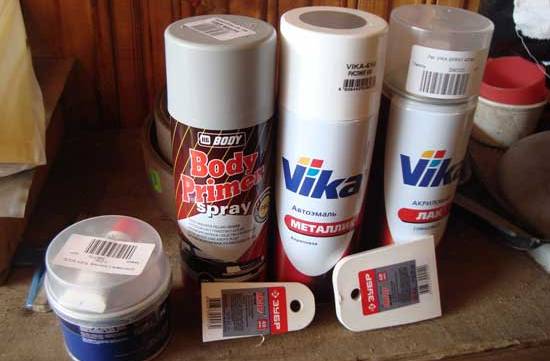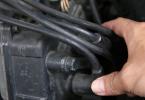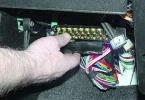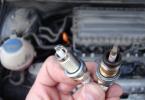Even on premium cars, plastic elements do not differ in particular reliability, so cases of repair and staining here are much more common here than with metal elements. Who is already familiar with the procedure This may not worry - the technology is almost the same, with the exception of some features associated with the chemical composition of plastics. In general, the appearance, both the interior components and plastic elements of the exterior, is easily restored at home, without visiting specialized car services.
Choose materials or how to paint plastic on your car and do not regret
If it is decided to restore the appearance of plastic products, it is important to first find out the type of material. In the automotive industry, two types of plastics are used. We will not consider their chemical components here, we are not only interested in the features of pretreatment and subsequent application of the LCP.
Any painting of the car plastic with your own hands on the video looks like a simple operation. In practice, first determine the type of plastics in the following two features:
- Combustion - Take a small piece from the repaired component and set fire to it, while it should not be paint residues or contaminants. If the flame is accompanied by black smoke and soak, then in pre-priming there is no need (only processing in fine-abrasive skurt). If plastic burns with a pure flame, then the soil for plastic is necessary.
- Buoyancy - Full immersion details from plastic indicates the lack of need for priming, if the part remains on the surface of the water, then without applying the soil it is not necessary.
Main materials
Before painting plastic on a car, you need to take care of the acquisition of consumables, including:
- Acetone or White Spirit.
- Primer for plastics (if necessary).
- Moisture-resistant sandpaper (P300 - P800).
- Paint for plastic products.
- Transparent acrylic varnish.

Practice has already shown that when restoring the LCP in some parts of the body, it is rational to do with aerosol paint. This approach is also rational and in our case, because the processed areas are small, and the acquisition of painting and compressor is expensive. In addition, it is impossible to exclude options when you can not do without a conventional painting brush.
How to dismantle the parts from plastics?
One of the important preliminary procedures is a neat dismantling of the desired components from the cabin and the outer plane of the body. The complexity lies in the fact that the options for their attachment for each model are individual, and in some cases it may be necessary to need a special tool. For example, to remove the dashboard on some cars can not do without a pin of a special configuration.
The presence of a set of universal tools will significantly simplify the coloring procedure. It is important to prevent the latch breaks and the loss of small parts when dismantling. For this use steel fork, as well as polyurethane blades and keys to dismantle car radio and climatic systems. So that in the future do not forget the location of all items, it is recommended to make intermediate photos of the disassembly process.
Technology Painting plastic car do it yourself at home and video workflows
The sequence and thorough execution of the color of the painting of elements from plastic guarantees the quality and durability of the LCP. With a methodology, if desired, you can familiarize yourself with the available video of the Master. Briefly, the list of works consists of items:
- Degreasing the surface with the help of a solvent or White spirit.
- To process the plastic part of antistatic (for example, Plak or Liqui Moly) so that dust attracts during the plane when staining.
- Before painting the old plastic on the car, you need to eliminate defects with a special putty, which is more elastic than the standard polyester.
- After drying, remove all irregularities using sandpaper P300 - P400.At the same time, the process must be carried out using water.
- Thoroughly dry the part and degrease its surface again.
- Protect the surface in 2-3 layers, avoiding the appearance of flops.
- The dried primer should be cleaned under the color with the help of abrasive skirt P400 - P500..
- The purified surface is applied 2-3 layers of acrylic paint with plasticizing additives, each layer needs drying for 15-25 minutes.
- After the final drying, a layer of varnish is applied.
- Polish polishing pastes finished surface LCP.
Methodik It has long been worked out, it is desirable to have grinding and the corresponding accessories. But if necessary, small areas can be handled manually.
Applying a brush when painting plastic parts of auto
It happens that painting with a bruster looks more convenient and more profitable than the balloon with aerosol paint. This way of painting a regular plastic car with your own hands on the video will not see. However, this does not say that it is not worth paying attention to him, on the contrary, it guarantees high-quality adhesion and good coating of small fragments. However, when working should take into account a number of features:
- Paint, applied using the brush, dries longer, so the drying period needs to be increased by 15-20 minutes.
- When staining, you need to try to provide the minimum layer thickness. To do this, in the process, the tassel should be well pressed to the surface and work quickly.
- Carefully remove the surplus paint about the edge of the jar.
- When working, you should withstand the same angle of staining.
On a note
Do not forget that nitroemal from the cans in its composition has an aggressive solvent. If you impose a thick layer of such a paint, then the plastic can dissolve, not all the item is, of course, but the surface is very likely.
To prevent such a result, it is better to use a special primer. In addition, it is impossible to apply the subsequent layer of paint without complete drying of the previous one.



